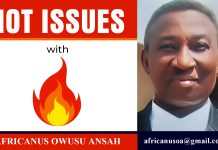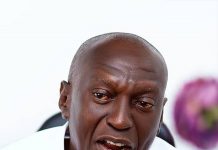“…Rather than to say, you are overtaxing the people… the thing about government investment and expenditure, is that the money does not come from anywhere. And especially you have a country, where the number of people who know they must pay tax on income do not exceed 30% of the population… only 70% of the population pay indirect tax… So, the only way you can raise money, really is through the tax system.
And the only way you can make everybody to contribute, is through indirect taxes…. It is not every decision that will be popular, but why was I elected for, as president, to take popular decisions? If I took popular decisions, to make you happy with me, this country will be in the ground by now. There are tough decisions.
I mean, do I take pleasure in imposing taxes on people? You look at the alternative and the alternative is worse. And so, you must take decisions that are in the national interest. The benefits might not be seen immediately, but in the future, people will see what benefits they have accrued from the decisions that were made.” – H.E. John Mahama (Eight years ago).
The above, which was the response from Ex-President John Mahama to a question by Bernard Avle, some eight years ago, came out strongly to defend higher taxes, as the only alternative to raise money for investments and development in the country.
He justified higher taxation. And typical of the National Democratic Congress (NDC), who always claim to be pro-poor, the ex-president included that those who use V8, pay more taxes (at the pump), than those who use trotro.
During the second term of the NDC’s Mills/Mahama regime, new tax laws under the “Tax Laws Project” were introduced. Among the new taxes imposed on Ghanaians were the following:
Capital Gains of companies taxed at 25% instead of 15% from 2015,
Corporate tax of 25% on private educational institutions in 2013,
Imposition of 15% capital gains tax on petroleum operations in 2013,
Imposition of 17.5% VAT/NHIL on auctioneers and promoters of public entertainment in 2014,
Imposition of 17.5% VAT/NHIL on Financial Services in 2015,
Imposition of 17.5% VAT/NHIL on the business of a gymnasium and spa in 2014,
Imposition of 5% VAT/NHIL on Real Estates in 2014,
Imposition of Special Import Levy of 1%-2% on CIF value of some exempt items from 2013 (outboard motors, fishing nets, agricultural machinery, dairy milking products, energy saving bulbs, book binding machines, cutlasses and some farming inputs),
Imposition of17.5% VAT/NHIL on pharmaceuticals other than retail in 2014,
Increase in VAT rate from 12.5% to 15% in 2014, and
Reintroduction of 5% National Fiscal Stabilisation Levy in 2013, among others.
If the NDC wanted to portray itself as been soft on the poor but hard on the well-to-do, it should know by now that whatever high tax the rich pay, the poor will surely be affected. We do not live in a country where general goods and services are sold separatelyto the rich and the poor. The same cost that the rich will pay for something, will be the same for the poor.
With such high tax policies, the suppliers will be urged to increase the cost of their products to unrealistic prices. While the rich could pay for them without feeling a dent in their pockets, the poor will have to struggle to find the means.
For example, the 17.5% VAT/NHIL on Financial Services, made both the rich and the poor, who paid school fees for their wards with bankers’ draft, find an extra 17.5% of the school fees, aside from bank charges, before they could acquire the banker’s draft.
If the school fees were GH¢ 1,000.00, and assuming bank charges were 2.5%, both the rich and the poor would find an additional GH¢ 175.00 for VAT/NHIL on the financial service and another GH¢25.00 for bank charges. Here it would be easier for the rich to get the additional GH¢200.00, than the poorcould.
The poor and the rich will go out to buy drugs from pharmacies and there will be no different costs. All will pay the same price. The 17.5% VAT/NHIL on pharmaceuticals, translated into paying higher direct tax. And here again, it is the poor who suffer most.
Interestingly, the previous NDC government, imposed a tax, the National Health Insurance Levy (NHIL), which was to fund the National Health Insurance Scheme. But, the NHIS collapsed under the NDC, so where did the money go to?
Also, VAT went from 12.5% to 15% and this affected all goods and services before the other taxes took effect. Take a pharmaceutical product which may cost GH¢100.00 at pre-retail. Before it got on the counter, it would cost GH¢115.00 (plus VAT) x 17.5% which will be GH¢135.13 or GH¢136.00. (This is the method the NDC used in calculating VAT, when it was first introduced during Rawling’s first term as president of the Republic).
Today, the NDC is attacking the Akufo-Addo’s administration of imposing killer taxes. The taxes imposed between 2017 to date, and strategically presented by a pro-NDC group, include the following:
3% VAT Flat Rate
1% COVID-19 levy on the 2.5% National Health insurance levy, making it 3.5% now.
5% financial sector clean-up recovery levy.
2% Special import levy (extended beyond expiry date of 2017)
1% COVID-19 levy on 3% VAT flat rate, making it 4% now.
1% COVID-19 levy on the 2.5% National Health insurance levy, making it 3.5% now.
5% financial sector clean-up recovery levy.
20 pesewas Energy Sector Recovery Levy on every litre of diesel and petrol
10 pesewas Sanitation levy (“Borla”) tax on every litre of diesel and petrol
18 pesewas energy sector recovery levy on every kilogram of LPG
30% increase in Energy Sector levies (ESLA), extended beyond its original duration of 5 years to now 15 years.
About 11% increase in Special Petroleum Tax (from 41 pesewas to 46 pesewas) on every litre of diesel and petrol.
Bost Margin from 3% to 9%.
67% increase in Fuel Marking Margin (from 3 pesewas to 5 pesewas) per litre of petrol and diesel.
40% increase in Price Stabilization and Recovery Levy on fuel products (from 10 pesewas & 12 pesewas on petrol and diesel respectively, to 14 pesewas and 16 pesewas on diesel and petrol respectively)
25% increase in Primary Distribution margin from 8 pesewas to 10 pesewas.
36% increase in Unified Petroleum Price Fund (UPPF) from 22 pesewas to 30 pesewas.
Increase in Road Fund Levy from 46 pesewas to 48 pesewas on every litre of diesel and petrol.
1% Electronic Transfer Levy Tax (E-Levy).
The following taxes were imposed during the first term (2017-2020), of the Akufo-Addo administration and were later withdrawn.
Luxury vehicle tax (GH¢1,000 to GH¢2,500 depending on engine capacity of vehicle).
50% increase in Communication Service Tax (CST).
Comparing the two governments, it is clear which one imposed affordable taxes and which one imposed killer taxes.
The 11% increase in Special Petroleum Tax, 67% increase in Fuel Marking Margin, 40% increase in Price Stabilization and Recovery Levy, 25% increase in Primary Distribution Margin and 36% increase in Unified Petroleum Price Fund, worked out in pesewas, by adding on at least two pesewas and at most eight pesewas.
If quoting percentage increases, can be described as killer taxes, then what about this.
On February 1, 2010, under the Fees and Charges (Miscellaneous Provisions) Act 2009 Act 793, the Mills/Mahama government increased road and bridge tolls, by very high percentages, some going in the thousands.
Among vehicles that ply the roads, motorbikes which were previously exempted were made to pay 10Gp. Saloon cars’ toll went from 5Gp to 50p (900%) and pick-ups, SUVs and light buses from 8Gp to GH¢1.00 (1,150%).
The Mills/Mahama administration which called itself pro-poor introduced taxes and levies beyond the reach of the poor. The poor became poorer during the PNDC/NDC era of Jerry John Rawlings, and the poor was not spared under the Mills/Mahama regime. And yet, we are told today, that the NPP is anti-poor.
The NDC introduced Special Import Levy of 1%-2% which was imposed on exempt items like outboard motors, fishing nets, cutlasses and farming inputs, which are things the poor use in their fields to get money. Is this pro-poor?
When the E-Levy was introduced by this administration, at 1%, the NDC went wild and convinced the poor that it was to make them poorer. The poor were advised to physically travel to people they have to give money to, instead of using electronic transfers, MoMo.
So, it made sense to the NDC that if you are in Accra and you have to give GH¢200.00 to someone in Kumasi, it will be cheaper going by bus on a return journey, and spending GH¢160.00 on bus fare alone, than paying an additional GH¢2.00 for E-Levy. Meanwhile you could have paid maximum GH¢4.00, to deliver the same amount. If you include charges, then you may pay only GH¢6.00.
Ghanaians should start cross-checking the statistics and they will find out, which political party administration, imposes killer taxes. Ghanaians must be wondering how much tax will be placed on electronic financial transfers, as indicated in Art. 8 (7c) of the NDC 2020 People’s Manifesto, if the opposition party had won the 2020 General Elections.
All these wars against the current NPP government by the NDC, is mere propaganda and giving the opportunity, as proven with statistics, the NDC always imposes harsher taxes and introduce austerity measures.
By Hon. Daniel Dugan









